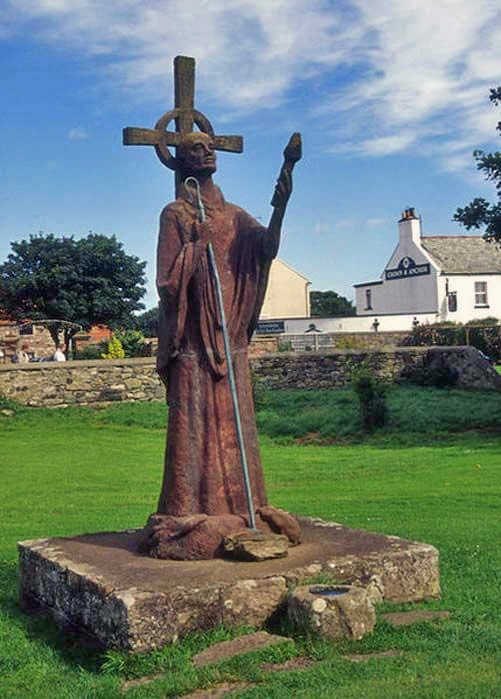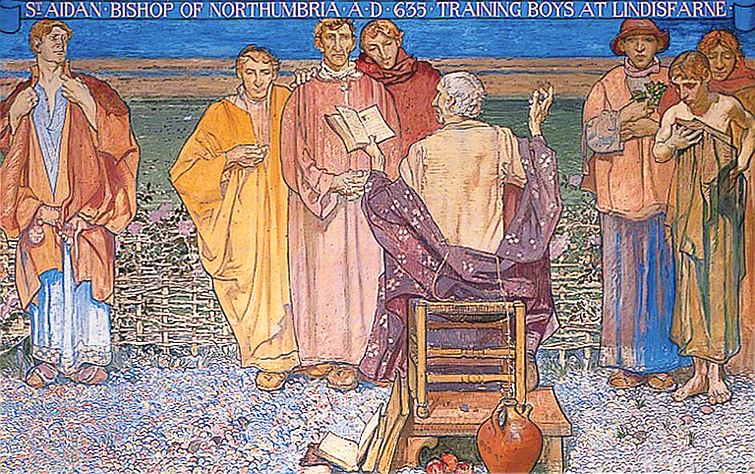Adapted from Various Sources.
St. Aidan, Bishop and Apostle of the Anglo-Saxons († 651; Feast – August 31)
 When the holy King St. Oswald desired the bishops of Scotia to send him a person
honored with the episcopal character to preach the Faith to his Anglo-Saxon pagan subjects, and plant the Church among them,
the first person who came was of a rough austere temper, and therefore could do little good. Being forced to return home again,
he laid the blame on the rude indocile dispositions of the English. Hereupon the Scottish clergy called a synod to deliberate
what was best to be done. Aidan, who was present, told the prelate, on his blaming the obstinacy of the English, that the fault
lay rather with him, who had been too harsh and severe with an ignorant people, who ought first to be fed with the milk of milder
doctrine, till they should be able to digest more solid food. At this discourse the whole assembly turned their eyes upon him,
as one endued with prudence, the mother of virtues; and he was appointed to the great and arduous mission.
When the holy King St. Oswald desired the bishops of Scotia to send him a person
honored with the episcopal character to preach the Faith to his Anglo-Saxon pagan subjects, and plant the Church among them,
the first person who came was of a rough austere temper, and therefore could do little good. Being forced to return home again,
he laid the blame on the rude indocile dispositions of the English. Hereupon the Scottish clergy called a synod to deliberate
what was best to be done. Aidan, who was present, told the prelate, on his blaming the obstinacy of the English, that the fault
lay rather with him, who had been too harsh and severe with an ignorant people, who ought first to be fed with the milk of milder
doctrine, till they should be able to digest more solid food. At this discourse the whole assembly turned their eyes upon him,
as one endued with prudence, the mother of virtues; and he was appointed to the great and arduous mission.
St. Aidan was a native of Ireland and a monk of Hij, the great monastery which his countryman, St. Columba, had founded
on the island of Iona (off the western coast of Scotland). He was most graciously received by King Oswald, who bestowed on him
for his episcopal see the isle of Lindisfarne (off the northeastern coast of England). From the great number of Saints who lived
and are buried there, it was called Holy Island.
Of St. Aidan's humility and piety, the Venerable Bede gives an edifying account, and proposes him as an excellent pattern
for succeeding bishops and clerics to follow. He obliged all those who travelled with him to bestow their time either in reading the
Scriptures or in learning the Psalms by heart. By his actions he showed that he neither sought nor loved the good things of this world;
the presents which were made him by the King or by other rich men, he distributed among the poor or expended in redeeming captives.
He rarely would go to the King’s table, and never without taking with him one or two of his clergy, and always after a short repast
made haste away to read or pray in the church or in his cell. From his example even the laity took the custom of fasting till the
Office of None, that is, till about three in the afternoon, on all Wednesdays and Fridays, except during the fifty days of Easter time.
St. Bede also admires his apostolic liberty in reproving the proud and the great, his love of peace, charity, purity, humility, and all
other virtues – which he not only practiced himself, but by his spirit and example communicated to a rough and barbarous nation, which
he imbued with the meekness of the Cross.
St. Bede also relates many miracles and prophecies of St. Aidan (Hist. l. 3, c. 15), and gives the following
portrait of the clergy and people of this nation, soon after their conversion to the Faith: Wherever a clergyman or monk came,
he was received with joy by all as the servant of God; and when any of them was traveling on his way, they would run up to him,
and bowing down, would be glad to be signed by his hand, or blessed by his prayer. They gave diligent attention to the words of
exhortation which they heard from him, and on Sundays flocked with great eagerness to the churches or monasteries to hear the Word
of God. If any priest happened to come into a village, the inhabitants presently gathering together were solicitous to hear from
him the words of life; nor did the priests or other ecclesiastics frequent the villages on any other account but to preach,
visit the sick, and take care of souls; and so free were they from any degree of the bane of avarice, that none of them would receive
lands or possessions for building monasteries, unless compelled to by the secular power
(Ibid. c. 26).

St. Aidan fixed his See at Lindisfarne and founded a monastery there in the year of Our Lord 635, one hundred and
eighty-eight years after the coming of the Anglo-Saxons into Britain, the thirty-ninth year after the arrival of St. Augustine
of Canterbury, and second of the reign of St. Oswald. From this monastery all the churches of Bernicia (the northern part of
the Kingdom of the Northumbers) had their beginning; as had also some of those of the Deiri, who inhabited the southern part
of the same Kingdom. The See of York had been vacant thirty years, ever since St. Paulinus had left it; so that St. Aidan governed
all the churches of the Northumbers for seventeen years, till his happy death on August 31, 651, in the royal villa Bebbord.
He was first buried in the cemetery at Lindisfarne; but when the new church of St. Peter was built there, his body was translated to it,
and deposited on the right hand of the altar. Some relics of St. Aidan were taken by his second successor as Bishop of Lindisfarne,
St. Colman – either to the Monastery of Hij, or to the Monastery of Mayo in Ireland.
Back to "In this Issue"
Back to Top
Back to Saints
Alphabetical Index; Calendar List of Saints
Contact us: smr@salvemariaregina.info
Visit also: www.marienfried.com


 When the holy King St. Oswald desired the bishops of Scotia to send him a person
honored with the episcopal character to preach the Faith to his Anglo-Saxon pagan subjects, and plant the Church among them,
the first person who came was of a rough austere temper, and therefore could do little good. Being forced to return home again,
he laid the blame on the rude indocile dispositions of the English. Hereupon the Scottish clergy called a synod to deliberate
what was best to be done. Aidan, who was present, told the prelate, on his blaming the obstinacy of the English, that the fault
lay rather with him, who had been too harsh and severe with an ignorant people, who ought first to be fed with the milk of milder
doctrine, till they should be able to digest more solid food. At this discourse the whole assembly turned their eyes upon him,
as one endued with prudence, the mother of virtues; and he was appointed to the great and arduous mission.
When the holy King St. Oswald desired the bishops of Scotia to send him a person
honored with the episcopal character to preach the Faith to his Anglo-Saxon pagan subjects, and plant the Church among them,
the first person who came was of a rough austere temper, and therefore could do little good. Being forced to return home again,
he laid the blame on the rude indocile dispositions of the English. Hereupon the Scottish clergy called a synod to deliberate
what was best to be done. Aidan, who was present, told the prelate, on his blaming the obstinacy of the English, that the fault
lay rather with him, who had been too harsh and severe with an ignorant people, who ought first to be fed with the milk of milder
doctrine, till they should be able to digest more solid food. At this discourse the whole assembly turned their eyes upon him,
as one endued with prudence, the mother of virtues; and he was appointed to the great and arduous mission.
